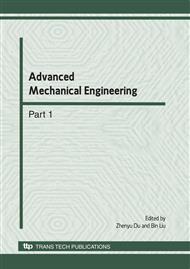[1]
KirbyRL, Tsai HY, Graham MM. Stepping out: how to select awalking device. J of JohnsHopkinsMed LettHealth, 2005, 17(9): 6-7.
Google Scholar
[2]
Corcoran PJ. Effect of plastic and metal legbraceson speed and energy costofhemiparatic ambulation. J of Arch Phys Med Rehati, l 2003, 51: 69-77.
Google Scholar
[3]
G.S. Virk, S.K. Bag, S.C. Gharooni, M.O. Tokhi, R.I. Tylor, S. Bradshaw, F. Jamil, I.D. Swain, P.H. Chapple, and R.A. Allen. Robotic Walking Aids for Disabled Persons. Engineering and Physical Sciences Research Council, GR/R10981/02, 801-811.
DOI: 10.1007/3-540-29461-9_78
Google Scholar
[4]
Giulio E. Lanvioni, Nirbhay N. Singh, Mark F. O'Reilly, Jeff Singafoos, Doretta Oliva, Giorgia Piazzolla, Sara Pidala, Angela Smaldone, and Francesco Manfredi. Automatically Delivered Stimulation for Walker-Assisted Step Responses: Measuring its Effects in Persons with Multiple Disabilities. Journal of Developmental and Physical Disabilities, Vol. 19, No. 1, February (2007).
DOI: 10.1007/s10882-006-9030-8
Google Scholar
[5]
Allen I. Janis. Propagation of Gravitational Waves in Robertson-Walker Backgrounds. General Relativity and Gravitation, Vol. 17, No. 6, (1985).
DOI: 10.1007/bf00763053
Google Scholar
[6]
Yang Jiankun, Jin Dewen, Ji Linhong, Wang Rencheng, Zhang Jichuan, Fang Xin, Zhou Dawei. Slip risk analysis for trans-femoral amputees during level walking. Journal of Tisnghua University (Science and Technology). 2006. 46V: 1854-1856.
DOI: 10.1109/iembs.2005.1615842
Google Scholar
[7]
MING Dong, GU Chengwei, NAN Wenya, LIU Shuangchi, SONG Wei, CHENG Longlong, WAN Baikun. Measurement and Analysis Method for Elbow Joint Moments During Walker-Assisted Walking. Transactions of Tianjin University, 2008, 14: 016-020.
DOI: 10.1007/s12209-008-0004-z
Google Scholar
[8]
Bateni H, Maki B E. Assistive devices for balance and mobility: Benefits, demands, and adverse consequences. J of Archives of Physical Medicine and Rehabilitation, 2005, 86(1): 134-145.
DOI: 10.1016/j.apmr.2004.04.023
Google Scholar
[9]
Hualong Xie, Fei Li, Zhongqi Sheng, Zhiwei Xu, Yongxian Liu. The Gait System Research of Intelligent Bionic Leg. Chinese Control and Decision Conference (CCDC 2009), 4622-4627.
DOI: 10.1109/ccdc.2009.5191693
Google Scholar
[10]
Vukobratovic M, Borovac B, Surla D, Stokic D. Biped Locomation: dynamic, stability, control and application [M]. Berlin: Germany: Springer-Verlag, (1990).
Google Scholar
[11]
Fumsho J, Masubuchi M. A theoretically motivated reduced order for the control of dynamic biped locomotion. J of ASME J. Dyn. Sys. Meas. Control (S0022-0434), 1987, 109(2): 155-163.
DOI: 10.1115/1.3143833
Google Scholar


